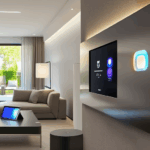“`html
From Concept to Reality: Innovations in Smart Home Technology
Introduction
The concept of a smart home has long been a vision of futuristic living, where technology seamlessly integrates with our daily routines to enhance comfort, convenience, and efficiency. What was once considered science fiction is now a tangible reality, transforming the way we interact with our living spaces. Over the past few decades, smart home technology has evolved from an abstract idea into a practical solution, offering homeowners unprecedented control and automation.
Smart homes leverage interconnected devices and systems to create an environment that can be managed remotely and tailored to individual preferences. This technology has become increasingly significant in modern living, offering not only convenience but also substantial benefits in terms of energy efficiency, security, and accessibility.
Key Components of Smart Homes
Smart Thermostats
One of the most popular components of smart homes is the smart thermostat. These devices, such as the Nest Learning Thermostat by Google and the Ecobee Smart Thermostat, learn your schedule and preferences to optimize heating and cooling, leading to significant energy savings. Advanced models can even adjust settings based on occupancy, weather forecasts, and user behavior.
Lighting Systems
Smart lighting systems allow users to control lights remotely via mobile apps or voice commands. Products like Philips Hue and LIFX offer customizable color options, dimming features, and scheduling capabilities. These systems can also integrate with other smart devices, such as motion sensors, to automatically turn on or off when needed.
Security Cameras
Smart security cameras provide real-time monitoring and recording capabilities, often with night vision and two-way audio. Brands like Arlo and Ring offer cloud-based storage and smartphone alerts, ensuring homeowners are always aware of what’s happening around their property. Many models also feature facial recognition and motion detection, enhancing overall security.
Voice Assistants
Voice assistants, such as Amazon Alexa, Google Assistant, and Apple Siri, serve as central control points for many smart home devices. Users can issue commands to adjust temperature, play music, check the news, and more, all through simple voice interactions. These assistants have become indispensable tools for managing complex smart home setups.
Smart Appliances
Smart appliances, including refrigerators, ovens, and washing machines, offer remote monitoring and control. For instance, Samsung’s Family Hub refrigerator allows users to view inventory, set reminders, and even stream music directly from the fridge. LG’s smart washing machines can be started and monitored remotely, ensuring laundry is ready when you need it.
Integration and Connectivity
For a truly seamless smart home experience, various devices must work together harmoniously. Integration involves connecting multiple smart devices into a single, cohesive system that can be controlled through a centralized hub or app. Different connectivity standards, such as Wi-Fi, Bluetooth, and Zigbee, play crucial roles in enabling this integration.
- Wi-Fi: Ideal for devices that require internet access, such as cameras and doorbells, Wi-Fi provides robust connectivity but can be less reliable for devices requiring constant communication.
- Bluetooth: Suitable for short-range communication between nearby devices, Bluetooth is commonly used for accessories like smartwatches and headphones.
- Zigbee: Designed for low-power, mesh networking, Zigbee enables efficient communication between numerous devices over extended distances, making it ideal for large smart home setups.
Hubs and central control systems act as the brain of a smart home, managing all connected devices and ensuring smooth operation. Popular hubs include the Samsung SmartThings Hub and the Wink Hub 2, which support a wide range of smart devices and protocols.
Advantages of Smart Home Technology
Convenience
Smart home technology simplifies everyday tasks, allowing users to manage multiple devices with ease. Whether it’s adjusting the thermostat, locking doors, or turning off lights, everything can be done with just a few taps or voice commands.
Energy Efficiency
Smart devices help reduce energy consumption by optimizing usage patterns. For example, smart thermostats can lower heating and cooling when no one is home, leading to significant cost savings on utility bills.
Security
Advanced security features, such as motion-detecting cameras and smart locks, provide enhanced protection against intruders. Many systems also send instant notifications to users’ smartphones, ensuring they’re always informed.
Accessibility
Smart home technology benefits individuals with disabilities by providing greater independence. Voice-controlled devices and automated systems enable users to perform tasks that might otherwise be challenging.
While smart home technology offers numerous advantages, concerns about privacy and data security are valid. Users should prioritize selecting reputable brands and taking precautions, such as enabling encryption and regularly updating software, to protect their personal information.
Future Trends and Innovations
The future of smart home technology holds exciting possibilities, with advancements in artificial intelligence (AI), advanced sensors, and Internet of Things (IoT) ecosystems leading the way.
AI-Driven Automation
AI will increasingly automate routine tasks, learning user preferences and adapting to changing conditions. For example, AI-powered systems could adjust lighting and temperature based on individual habits, ensuring optimal comfort at all times.
Advanced Sensors
Sensors capable of detecting environmental factors, such as humidity, air quality, and even emotions, will enhance smart home functionality. These sensors could trigger actions like opening windows to improve ventilation or playing soothing music to reduce stress.
IoT Ecosystems
The growth of IoT ecosystems will foster greater interoperability among devices, allowing them to communicate seamlessly across different platforms. This will enable more sophisticated integrations and personalized experiences.
Conclusion
Smart home technology has come a long way since its inception, evolving from a niche concept to a mainstream solution that enhances modern living. By integrating various components and leveraging advanced connectivity, smart homes offer unparalleled convenience, energy efficiency, security, and accessibility.
As technology continues to advance, we can expect even more innovative solutions that further enhance the smart home experience. Embracing these advancements will undoubtedly shape the future of living environments, making homes smarter, safer, and more enjoyable places to live.
We encourage readers to explore the possibilities of integrating smart home solutions into their own lives, unlocking the full potential of this transformative technology.
“`


